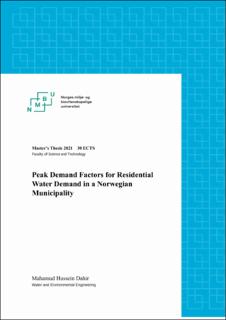| dc.contributor.advisor | Rydningen, Ulf | |
| dc.contributor.advisor | Nilsen, Vegard | |
| dc.contributor.advisor | Lindholm, Oddvar | |
| dc.contributor.author | Dahir, Mahamud Hussein | |
| dc.coverage.spatial | Norway | en_US |
| dc.date.accessioned | 2021-12-07T09:24:02Z | |
| dc.date.available | 2021-12-07T09:24:02Z | |
| dc.date.issued | 2021 | |
| dc.identifier.uri | https://hdl.handle.net/11250/2833057 | |
| dc.description.abstract | A well-designed and dimensioned pipeline system for water transport networks is required in order to deliver the required demand for drinking. A good estimation of the quantity of water to be consumed by the users in a certain area is therefore needed. Generally, water usage in private households vary according to the period. Peak factors are used to determine the size, design and dimensioning of water and wastewater supply pipes. Since there is a variation in consumption, the calculation is multiplied by a factor for the hourly and daily variation. Norwegian water (norsk: Norsk Vann) uses standardised values in recommending which factor to use. However, the origin of these factors could not be traced to Norwegian literature. Swedish publication P83 developed by the Swedish water (Svenskt Vatten) is mostly referred to. This has given rise to the need for a study based on recent water consumption in a typical household in Norway.
Smart water readers were used in this data collection procedure. This paper analyses the demand of a municipality’s household consumption and has a population of less than 5000 people. Hourly and diurnal measurements was analysed for a period of 239 days of 2019. Based on the results shown, we can conclude that even though a more detailed study is needed, there is some correspondence in range between the Norwegian peak demand factors and those suggested by the Swedish publication.
Both diurnal and hourly demand factors were calculated using consumption from a Norwegian municipality. Result range for both agrees with the range used by the abovenamed publications. The extent of this analysis is limited with the small population of the municipality. However, the results show that the hourly demand factor reduces as the population increases. | en_US |
| dc.description.abstract | Det kreves et godt utformet og dimensjonert rørledningssystem for vanntransportnett for å levere den nødvendige mengde vann. Det er derfor nødvendig å estimere mengden vann som forbrukerne bruker i et bestemt område. Generelt, varierer vannforbruk i husholdninger. Variasjons-faktorer brukes til å bestemme størrelse, utforming og dimensjonering av vann- og avløpssystem. Siden det er en variasjon i forbruket, multipliseres beregningen med en maks døgnfaktor og maks timefaktor. Norsk Vann rapporter bruker standardiserte verdier for å anbefale hvilke faktorer som skal brukes. Vi kunne ikke finne hvor opprinnelig disse faktorer beregnes fra i norsk litteratur. Svensk publikasjon P83 er derfor mest referert til. Dette har gitt behovet for en studie basert på nylig vannforbruk i en typisk husholdning i Norge.
Smarte vannmålere ble brukt i denne masteroppgave. Det analyseres husholdningsforbruk i en norsk kommune som har under 5000 innbyggere. Time og døgnforbruk ble analysert for en periode på 239 dager i 2019. Basert på resultatene som er vist, kan vi konkludere med det finnes noe samsvar mellom de norske maks variasjonsfaktorene og de som anbefales av den svenske publikasjonen. | en_US |
| dc.language.iso | eng | en_US |
| dc.publisher | Norwegian University of Life Sciences, Ås | en_US |
| dc.rights | Attribution-NonCommercial-NoDerivatives 4.0 Internasjonal | * |
| dc.rights.uri | http://creativecommons.org/licenses/by-nc-nd/4.0/deed.no | * |
| dc.subject | Water distribution | en_US |
| dc.subject | Vannmålere | en_US |
| dc.subject | Vannfordeling | en_US |
| dc.title | Peak demand factors for residential water demand in a Norwegian municipality | en_US |
| dc.type | Master thesis | en_US |
| dc.description.localcode | M-VM | en_US |

